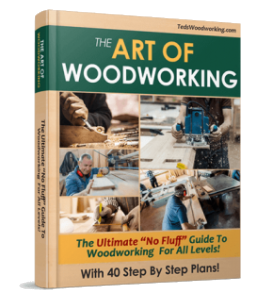First Things First
Before you ever power up your first woodworking tool it’s important to know how to operate your woodworking hobby or business safely to avoid serious injury or even death. That’s why we’ve put together this list of recommended woodworking safety tips. We hope you find this information helpful and take seriously the suggestions we’ve provided.
Our list of woodworking safety tips are categorized into 4 sections:
- General Woodworking Safety
- Personal Woodworking Safety
- Workshop Safety
- Power Tool Safety
You’ll find additional information from OSHA at the end of this article. We recommend you review that information as well. It will further your knowledge of woodworking safety which can only serve to make your life that much better.
General Woodworking Safety
USE COMMON SENSE
We all know at least one person that doesn’t have a lick of sense between his ears. Thankfully, that’s neither you nor me. But it goes without saying (even though I’m saying it now) that in order to stay alive you’ll need to employ your gift of common sense when it comes to woodworking. Simply having it could literally save your life so use it when you need it!
DON'T USE DRUGS OR ALCOHOL
We’ve already established that you possess the gift of common sense so it’s safe to assume that you already know that using any type of substance that impairs you in any way is not a smart thing to do before or during work in your woodshop. Stay safe and don’t do drugs, m’kay? You can have that beer later after your hard work in the shop is finished.
NO SMOKING
Smoking while woodworking is just plain dumb especially if you have a dirty, dusty woodshop. There are so many things in your shop that can potentially catch fire and it just makes sense to eliminate the possibility of igniting any of it by lighting up that little cigarette. Not worth it dude. Smoke later when you’re not working.
NEVER WORK WHEN YOU'RE TIRED
Would you drive while tired? Probably not. Why? Because it’s dangerous. Same thing applies in the shop. If you’re tired there’s a greater chance that you won’t be quite as alert as you would be when well rested. And scenarios like that can spell disaster. No need to lose a finger or hand just because you’re tired. Go take a nap and come back to your project when you’re fresh and full of energy. You’ll be glad you did.
ELIMINATE DISTRACTIONS
Working around machinery, especially machines with rotating blades, can be dangerous and potentially fatal. It requires the utmost concentration and focus when making that cut and if you become distracted it can, at best, mean your cut isn’t perfect, and, at worst, kill you. Focus on what you are doing and do everything in your power to eliminate potential distractions before they occur.
ASK FOR HELP WHEN NECESSARY
Some of us (men, that is) have a hard time asking others for help. I don’t know if it’s testosterone, pride, ego, or just plain stupidity, but we generally don’t like to admit we can’t do something on our own. Well, sometimes we need help. So if you find yourself in a situation where you need help then by all means ask someone to help you. Humble yourself and swallow your pride because it could literally save your life.
Ladies, you probably don’t have this issue but just please reach out and ask for help when you need it. If something is too heavy, too big, or whatever, sometimes it just takes 2 to get the job done.
Personal Woodworking Safety
PERSONAL PROTECTIVE EQUIPMENT (PPE)
The most valuable asset in your workshop is you. Be sure you take all necessary precautions to protect yourself. This includes wearing ear and eye protection, using a face shield, and donning a respirator mask when necessary (when working with finishes or other chemicals for example).
And, since you’ll be lifting, twisting, turning and moving things from place to place, don’t forget to protect your back as well. Having a really good back brace is key to avoiding injuries and reducing or eliminating pain.
WEAR PROPER CLOTHING
Clothing can play an important part in protecting you from some of the dangers of woodworking. It’s important to wear pants and shirts that are thick enough to prevent being penetrated by small flying objects like chunks of wood for example. Avoid wearing loose fitting clothing that could get caught in cutting blades.
When appropriate wear gloves to protect your hands.
Remove all jewelry before you start working, especially any dangling jewelry like necklaces or bracelets.
To protect your feet consider buying a good pair of steel-toed safety boots and if you have long hair (ladies) be sure to secure it so it’s not prone to getting tangled in any of your equipment. It would suck to be scalped by your tools. No, seriously… that would really suck!
Workshop Safety
KEEP WORKSHOP WELL VENTILATED
When working in your shop you’re going to encounter a lot of dust and other irritants like chemicals. It’s important to not create an environment where that stuff can linger and cause respiratory issues. Have an open window, open your garage door, and use a shop fan to keep you from breathing them in.
KEEP FLOORS CLEAN
Having dirty floors can lead to accidents. Clean them and keep them that way. It’s as simple as that.
KEEP TOOLS & WORKSHOP FREE OF SAW DUST
Allowing sawdust to accumulate on your tools and in your shop is a hazard. The added dust on the tools acts like an insulator and can increase the heat created by the tool. Having sawdust all about your shop is not only a potential fire hazard but can lead to respiratory issues as well. Clean that crap up and take care of your health.
AVOID HORSEPLAY
The woodshop is not a place to screw around. If you feel like you need to take a break and rough-house with someone go do it outside away from all the machines and tools.
BE AWARE OF OTHERS IN THE AREA
If your workshop is in a garage you’re probably working alone most of the time. However, it’s important to always be aware of your surroundings and of others so that they do not get injured. This is especially true of children and pets because they don’t always have the knowledge, know-how, and experience required to know when a situation or environment might be dangerous.
KEEP A FIRST-AID KIT NEARBY
You never know when you may have a small accident that requires personal medical attention, like a cut or scrape. Being able to tend to it quickly is important and gets you back in the game sooner rather than later. For more serious accidents be sure to have a phone nearby in case you need to call for help.
KEEP AND MAINTAIN A WORKING FIRE EXTINGUISHER
If something catches on fire how do you plan to put it out? Well, having a fire extinguisher on hand would be helpful. Make sure it’s well maintained and has been properly inspected. Most of all, learn how to use it.
In addition to having a fire extinguisher you might also consider investing in a few fire blankets to keep nearby.
Power Tool Safety
LEARN HOW TO PROPERLY USE EACH TOOL
Before you even think about powering up a bladed tool you should learn how to use it properly.
There are a few ways you can do this:
- If you already know a competent woodworker then have that person mentor you on the proper use of the tool
- Sign up for a woodworking safety class where you can have an experienced instructor teach you the basics
- Go online and search for how-to videos on proper tool use
- RTFM – Read the Freakin’ Manual
DO NOT attempt to use any tool without the proper training. Given the potential for serious injury it can be dangerous and it’s not worth the risk.
KNOW WHERE ON/OFF SWITCHES ARE ON ALL TOOLS
In the event of an emergency it’s critical that you know where all of the on/off switches are on your equipment. Making a split-second decision to turn off a machine that is inches away from causing injury can literally save a life. So get to know your tools and memorize where those on/off switches are.
USE A SINGLE EXTENSION CORD WHENEVER POSSIBLE
Since you can only do one thing at a time it makes sense to have only one power tool plugged in at a time. Using a single extension cord for all of your equipment is safer, too, because it means that only the tool you’re currently working with will have a spinning blade. When you need to use another tool simply remove the extension cord from one tool to the next.
Using a single extension cord also keeps your workshop free from tripping hazards that can occur when multiple cords are strewn all about the shop floor and possibly tangled up.
NEVER REACH OVER A SPINNING BLADE
Reaching over a spinning blade can cause serious injury and possibly death if, during your reach, you happen to slip or fall. If whatever you need to reach for cannot be safely retrieved any other way then you should immediately power off the tool, remove the tool from electrical power, and then retrieve whatever it was you were reaching for in the first place.
KEEP HANDS AND FINGERS AWAY FROM CUTTING AREAS
Sometimes it’s necessary to push wood through a cutting blade in close quarters but you don’t want to lose your precious fingers in the process. Always be aware of the proximity of your hands to the blade and take necessary precautions.
USE A PUSH STICK FOR CUTTING WOOD
A great solution for saving those hands from total annihilation is a push stick. It will help you guide the wood safely through the blade while keeping your hands protected from the spinning blade.
WORK AGAINST THE CUTTER
What the hell does this mean? It means that when you feed the wood into your cutting blade you want to make sure you feed it in the opposite direction that the blade is spinning.
Why is that?
By feeding the wood into the blade opposite the direction it is spinning you ensure that the force of the blade is pushing down on the wood and not up. This ensures that the wood stays securely on the cutting surface.
If you feed your wood into the blade in the same direction the blade is spinning then the blade can force the wood to fly upwards or dangerously kickback into your body.
USE BLADE GUARDS WHEN CUTTING WOOD
This topic seems to be a tiny bit controversial depending on who you ask. Some woodworkers with years of experience say they don’t like the idea of using blade guards when cutting wood because it causes them to have less control over the wood going through the cutting blade. But, at the same time, they advocate for safe woodworking practices so they recommend using a push block instead.
But, on this site, we’re recommending the use of blade guards (and push sticks) when cutting wood especially if you are a beginner woodworker. Making sure that blade cannot come in contact with your body is worth taking some extra precautions. Whatever you choose to do just make safety a first priority.
DISCONNECT POWER BEFORE CHANGING BLADES
From time to time you’ll need to change your blade for one reason or another. When you do make sure to completely remove electrical power from the tool before you even think about putting your hands near the blade. Unless you like the idea of losing fingers or a hand be sure to unplug that tool first.
SHARPEN YOUR BLADES
Over time blades are going to dull with use so it’s important to maintain them to prevent damage. Cutting with dull blades results in a lower quality cut and makes it harder to push the wood through the blade. Dull blades won’t cut as fast as sharp ones will and this causes more heat to be generated on the blade. That extra heat can cause the blade to warp which, obviously, is an undesirable outcome. So keep your blades sharp!
RECOMMENDED READING
OSHA: Occupational Safety and Health Administration
About OSHA
With the Occupational Safety and Health Act of 1970, Congress created the Occupational Safety and Health Administration (OSHA) to ensure safe and healthful working conditions for workers by setting and enforcing standards and by providing training, outreach, education and assistance.
~ Source: https://www.osha.gov/aboutosha
If you already own a business and have employees or you’re just simply interested in knowing more about OSHA’s stance on woodworking safety be sure to review their guide written specifically for the industry. It has a lot of really good information that you may not be aware of.
Woodworking safety is a critically important topic that should be top of mind for you in your woodworking hobby or business. This guide should serve as a launching point to get you thinking about safety as you move forward with your work. If you think there’s a tip we’ve forgotten to add to our list leave us a comment below and let us know.
Good luck, have fun, and always be safe!




